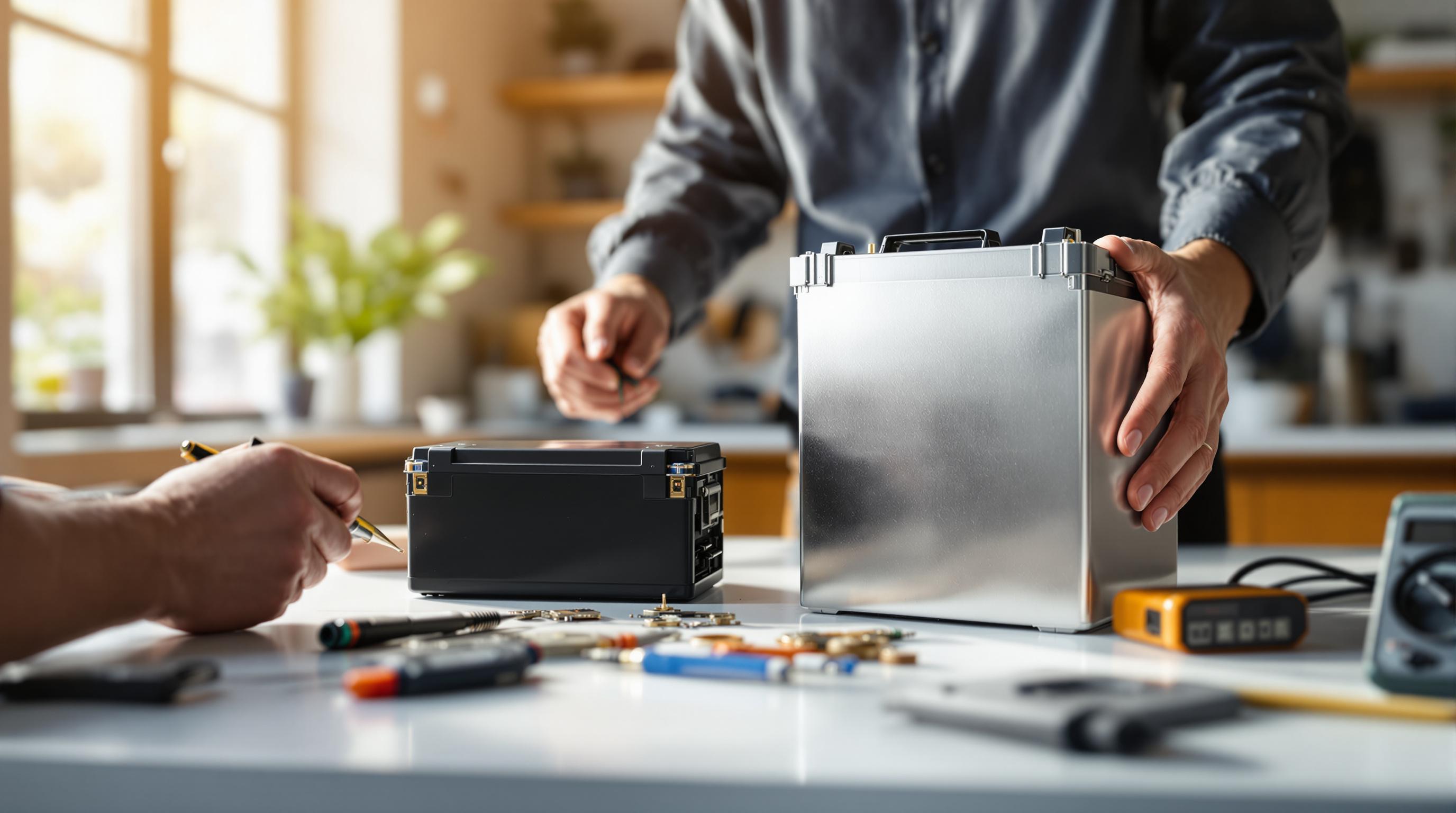Battery Repair vs Replacement: Cost Breakdown

Battery Repair vs Replacement: Cost Breakdown
Deciding between repairing or replacing your e-bike battery can save you money and improve your bike's performance. Here's a quick guide:
- Repair Costs: $150–$400. Best for minor issues like faulty cells or BMS fixes. Ideal if the battery is under 2 years old and holds 80%+ capacity.
- Replacement Costs: $600–$1,200. Necessary for older batteries (3+ years), severe wear, or reduced capacity below 70%. OEM batteries are pricier but offer quality and warranties, while aftermarket options are budget-friendly.
Quick Comparison:
| Scenario | Action | Cost Range |
|---|---|---|
| Minor cell issues (<2 years) | Repair | $150–$300 |
| Multiple dead cells (3+ years) | Replace | $600–$1,200 |
| BMS malfunction | Repair | $150–$250 |
| Capacity below 60% | Replace | $600–$1,200 |
Key Takeaway: Repair for small, cost-effective fixes. Replace for long-term reliability and performance. Always consult certified technicians for accurate diagnostics and service.
Battery Repair Costs
Standard Repair Prices
The cost of repairing an e-bike battery depends on the specific issue and the battery's design. Professional repair services evaluate the battery's condition before providing a detailed quote. To get accurate pricing, reach out to local repair shops that specialize in your type of battery.
What Affects Repair Costs
Several factors play a role in determining how much you'll pay for an e-bike battery repair:
- Battery specifications: This includes details like voltage, capacity, cell arrangement, and the manufacturer.
- Repair complexity: The number of cells that need replacing, how accessible components are, and the tools required all impact the cost.
- Market conditions: Factors like the availability of replacement parts, labor costs, and the technician's skill level also influence pricing.
These elements collectively shape the overall repair expenses.
Common Repairs and Prices
Typical e-bike battery repairs include replacing cells, fixing the Battery Management System (BMS), repairing connectors, and addressing wiring or housing issues. Smaller fixes, such as cleaning connectors, are generally more affordable. On the other hand, larger jobs - like replacing multiple cells or a full BMS - can be more expensive. Diagnostic services are often used to pinpoint issues, and their fees are usually applied toward the final repair cost. Keep in mind that prices can vary depending on your location and the repair provider.
Battery Replacement Costs
New Battery Market Prices
The cost of replacing an e-bike battery depends largely on the brand and model. High-capacity batteries (500Wh or more) from well-known brands like Bosch, Shimano, and Yamaha typically range between $600 and $1,200. Mid-range alternatives from brands like Bafang and Juiced Bikes are more affordable, costing between $350 and $700.
Here’s a quick look at some popular e-bike battery options:
| Brand & Model | Capacity | Price Range |
|---|---|---|
| Bosch PowerPack | 500Wh | $799-$899 |
| Shimano STEPS | 630Wh | $899-$999 |
| Bafang Standard | 48V 15Ah | $449-$549 |
| Rad Power Bikes | 48V 14Ah | $549-$649 |
Factors That Influence Prices
Several factors play a role in determining the cost of a replacement battery:
- Battery Chemistry: The type of lithium-ion formulation (like NMC or LFP) impacts both price and performance.
- Voltage and Capacity: Batteries with higher voltage or capacity ratings tend to cost more.
- Brand Premium: Established manufacturers often charge more for their reputation, quality, and warranty coverage.
- Integration Features: Batteries with advanced features, such as smart systems or specialized mounting, come at a higher price.
OEM vs Aftermarket Batteries: A Cost Comparison
When choosing between original (OEM) and aftermarket batteries, here’s how they stack up:
| Aspect | OEM Batteries | Aftermarket Batteries |
|---|---|---|
| Average Cost | $600-$1,200 | $300-$700 |
| Warranty | 2-3 years | 6 months-1 year |
| Compatibility | Guaranteed fit | May need modifications |
| Performance | Matches original specs | Varies by brand |
| Quality Control | Strict standards | Varies significantly |
Aftermarket batteries are generally cheaper upfront, but they may not last as long or perform as reliably as OEM options. However, trusted aftermarket brands like UPP and Unit Pack Power offer dependable options at lower prices, making them a good alternative for budget-conscious buyers. Balancing immediate savings against long-term reliability is key when deciding which route to take.
Cost vs Benefit Analysis
Immediate vs Future Costs
When deciding between repair and replacement, think about the short-term versus long-term expenses. Repairs usually come with a smaller upfront cost, but they might only provide a temporary fix. Over time, repeated repairs can add up to the cost of a new battery. On the other hand, a new battery requires a bigger initial payment but offers longer-lasting performance and less upkeep.
Battery Life and Output
Repairs typically can't bring a battery back to its original capacity, which means reduced range and fewer effective charging cycles. This might work for casual riders who don't travel far. But if you need consistent, long-distance performance, a new battery is the better choice. It operates at full capacity and delivers steady, reliable power. Plus, this difference in performance often ties into warranty considerations.
Warranty Coverage
Repair warranties tend to be limited, covering only specific components for a short time. In contrast, new batteries from trusted brands often come with comprehensive warranties that can even be transferred. These warranties help cut down on future costs if problems occur.
Ultimately, the decision comes down to the battery's current condition, age, and how you use it. If the battery is in good shape and the issues are minor, repairs might be a practical option. But for batteries that are heavily worn or have recurring problems, replacement is the better choice for long-term dependability and value.
Electric Bike Battery Repair: Refurbish or Replace?
How to Choose
After evaluating the costs, deciding between repair and replacement comes down to the battery's condition, performance, and the cost of repairs.
Best Times to Repair
Repair makes sense when the issues are minor and the battery is still in decent shape. Opt for repair if:
- The battery is less than 2 years old and has only minor problems.
- The issue is limited to a few faulty cells.
- The battery still holds at least 80% of its original capacity.
- The repair costs are less than 40% of the price of a new battery.
- There are connection or wiring problems.
If these conditions aren't met, replacing the battery might be the smarter choice.
When to Buy New
Go for a full replacement when the battery shows severe wear or when repair costs are too high. Replace the battery if:
- It's over 3 years old and holds less than 70% of its original capacity.
- Multiple cells have failed.
- Repair costs are more than 50% of the price of a new battery.
- There’s visible physical damage.
- The range is less than half of what it used to be.
- Charging takes 50% longer than it originally did.
As mentioned earlier, if repair costs exceed 50% of the price of a new battery, replacing it offers better long-term value.
Battery Care Guide
Taking care of your battery can help it last longer. Here are some tips for storage and maintenance:
- Keep the charge level between 40-80% when the battery isn’t in use.
- Store it in temperatures between 41°F and 77°F (5°C–25°C).
| Storage Duration | Recommended Charge Level | Check-up Interval |
|---|---|---|
| 1-2 weeks | 40-60% | Weekly |
| 1-3 months | 60-80% | Monthly |
| 3+ months | 40-50% | Every 3 months |
What to Avoid:
- Charging right after a ride.
- Storing the battery fully charged.
- Letting the battery completely discharge.
- Using chargers that aren’t approved.
- Exposing the battery to direct sunlight.
- Storing it in freezing temperatures.
Perform maintenance checks every 3-6 months to inspect connections, charging behavior, and overall performance.
Finding Service Providers
Picking a certified technician is key when it comes to e-bike battery repair or replacement. The right service provider can make a big difference in both the cost of repairs and your satisfaction with the results. Tools like Electric Bike Repair Near Me can help you locate certified professionals in your area quickly.
Electric Bike Repair Near Me

Electric Bike Repair Near Me is a nationwide directory that connects you with certified technicians. It offers detailed listings of repair shops and services, covering everything from diagnostics to repairs and even mobile support.
Here’s what to check when choosing a provider:
- Certification for specific manufacturers
- Experience with your particular battery model
- Access to professional diagnostic tools
- Liability insurance for added protection
- Whether they use OEM or aftermarket parts
- Post-repair testing to ensure everything works
- Availability of temporary replacement batteries
- Multiple quotes from certified technicians for comparison
Before starting any repairs, the technician should run thorough diagnostics to assess your battery's condition and recommend the right services. This step ensures you get accurate and effective solutions.
Conclusion
Deciding between repairing or replacing your e-bike battery comes down to balancing costs and performance. Your choice impacts both short-term expenses and the long-term reliability of your e-bike.
Here’s a quick breakdown of the main factors to consider:
- Battery Age: Batteries older than 3 years are usually better off replaced.
- Cost Comparison: Repairs typically cost $150–$400, while new batteries range from $600–$1,200.
- Performance Needs: Think about your daily range and charging habits.
- Warranty: Review your battery’s warranty for potential coverage.
- Service Availability: Check for local, certified technicians who can handle repairs or replacements.
Regular maintenance is key to extending battery life. Simple practices like keeping the charge between 40%–80% and avoiding extreme conditions can save you money over time.
Here’s a cost guide to help with your decision:
| Scenario | Recommended Action | Typical Cost Range |
|---|---|---|
| Minor cell issues (under 2 years old) | Repair | $150–$300 |
| Multiple dead cells (over 3 years old) | Replace | $600–$1,200 |
| BMS malfunction (any age) | Repair | $150–$250 |
| Capacity below 60% | Replace | $600–$1,200 |
For the best results, work with certified technicians - like those listed on Electric Bike Repair Near Me (https://electricbikerepairnearme.com). They can provide accurate diagnostics and the right solution, helping you balance costs while keeping your e-bike running reliably.